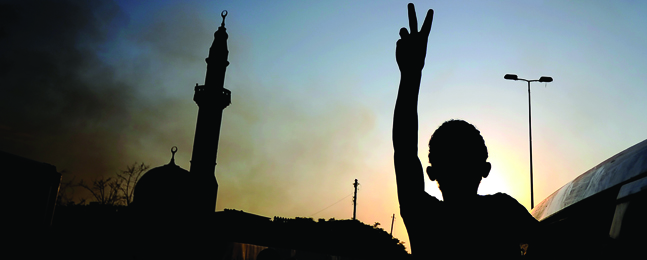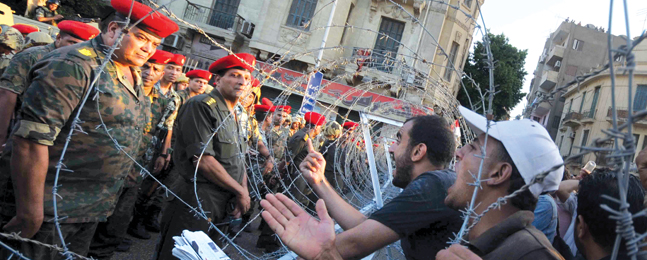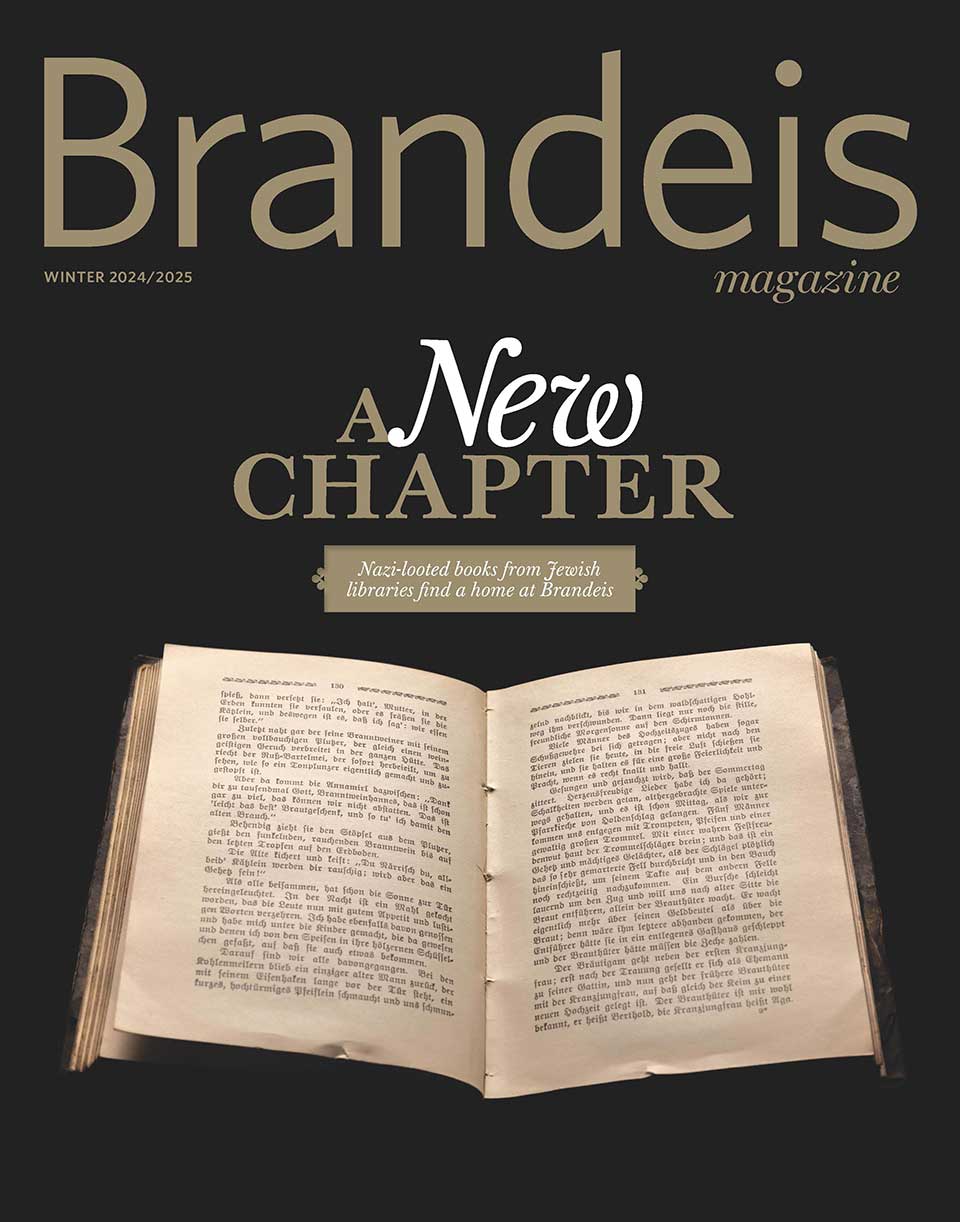Beyond the Arab Spring
Can popular opinion, the so-called Arab Street, pave the way for a more democratic neighborhood in the most repressive region in the world?

A youth flashes a celebratory victory sign after rebel forces overrun Muammar Qaddafi’s fortified headquarters in Libya’s capital, Tripoli.
by EVA BELLIN
On Dec. 17, 2010, in a remote town in Tunisia, a young fruit vendor named Mohamed Bouazizi, made hopeless by economic hardship and governmental harassment, protested his plight by dousing himself with gasoline and setting himself alight.
This sad episode ignited a conflagration that soon swept the entire Arab world. Popular protest exploded across the region. Within eight weeks, two deeply entrenched authoritarian rulers, Tunisia's Zine el-Abidine Ben Ali and Egypt's Hosni Mubarak, had been jettisoned from office. By late spring, four other regimes — Libya, Bahrain, Yemen and Syria — appeared to be in grave jeopardy. In the wake of these events, nearly every regime in the region scrambled to concoct the “right” mix of repression and strategic state largesse, to keep a lid on political upheaval. Some succeeded. Others did not.
 |
|
Sidebar Stories |
 |
These events astonished Middle East analysts and activists alike. How could this sudden flare of protest be explained? And why, despite their common genesis, had these protests taken Arab countries in such different directions?
The uprisings can be traced to several factors: long-standing grievances shared throughout the region; powerful emotional triggers that inspired ordinary citizens to take to the streets; and widespread use of social media that made mass protests less costly and more feasible, even in the face of authoritarian rule. By contrast, each country's political response hinged on state strength, religious or ethnic homogeneity, and international alliances that made concession to the protesters a necessity for some regimes but a desperate impossibility for others.
THE IMPULSE TO PROTEST
Most countries in the Arab world had long been afflicted with a triad of distress: economic hardship, repression and corruption. Although many countries in the region had experienced solid economic growth rates in recent years (thanks in no small part to the rise in world oil prices), this growth was unevenly distributed, and most countries were still burdened with serious poverty. Economic hardship was especially evident in rural areas (often neglected by development plans) as well as among the young and the educated, whose unemployment rates frequently tallied 25 to 30 percent.
Growth had not resolved this problem. If anything, it made the plight of the poor and unemployed all the more politically volatile because it exacerbated economic inequality. It is harder to endure deprivation when your nose is pressed up against the proliferating icons of middle-class consumption: shiny new malls, internationally branded fast food outlets and cafés, and fancy new cars.
Besides economic hardship, authoritarianism weighed heavily on the Arab world — long considered the most repressive region anywhere. Civil liberties are routinely violated. Political activists are harassed and arrested — if not worse. Newspapers are censored. Elections are scammed. The 1990s saw a modicum of political liberalization in the region, but many of the reforms introduced turned out to be little more than facades. Rarely did they introduce the sort of institutional change that would deliver true political freedom and accountability. If anything, analysts spoke of the development of “liberalized autocracies” in the region — the emergence of regimes that embraced distorted versions of democratic institutions, such as elections and party politics — which, paradoxically, served to prolong the survival of authoritarianism rather than foster political opening.
Corruption was also a persistent source of grievance in the Arab world. Power is the route to riches in the region, rather than the reverse, and cronyism is the norm in business-state relations. Without the institutions that make government officials accountable, such as a free press and truly competitive elections, there is little to curb their corruption. WikiLeaks’ revelations of pet tigers, expensive yachts and luxurious villas owned by the family of President Zine el-Abidine Ben Ali only confirmed what Tunisians had long known about the corruption of the ruling elite. And Tunisia was not the worst offender in this regard.
But just as infuriating as the corruption and conspicuous consumption of the ruling elites was the petty graft that citizens confronted in their everyday lives: the constant demand from minor bureaucrats for bribes, and the pervasive reliance on connections rather than merit in the distribution of government services and opportunities. This lowlevel sleaze posed a constant affront to citizens’ sense of fairness and dignity and fueled deep resentment against the regimes in power.

Egyptian soldiers stand guard behind barbed wire as protesters demonstrate outside the defense ministry, headquarters of the Supreme Council of the Armed Forces in Cairo.
page 2 of 3
A FULL RANGE OF EMOTION
But while all these long-standing injustices helped fuel the protests of 2011, they cannot alone explain their occurrence or their timing. Why did people mobilize now? Ordinary people do not take to the streets in mass numbers due to extensive meditation over ideology or policy. Ordinary people take to the streets because they are propelled by strong emotion, positive or negative. In the case of Tunisia, it was a sense of outrage on two levels: fury over the self immolation of Mohamed Bouazizi (who symbolized the despair and humiliation so many Tunisians felt) and, shortly thereafter, deep anger at the decision of the Tunisian police to shoot to kill unarmed civilians protesting the Bouazizi affair.
Outrage proved to be tinder in Egypt as well. There, citizens were enraged by the murder of a political activist named Khaled Said (a Facebook page was devoted to documenting his brutalization in graphic detail) as well as by the “stolen” elections of November 2010. The soaring prices of basic food commodities in midwinter did not help matters, either.
 |
|
Sidebar Stories |
 |
But in Egypt, fury was not the only emotion impelling mass protest; in fact, a sudden surge of hope, even euphoria, overshadowed anger in rallying people. It is doubtful that the protests in Egypt would have gathered such steam in January and February had it not been for Tunisians’ success, just weeks before, in so quickly unseating their own dictator. The toppling of Ben Ali in Tunisia suddenly made people believe that the impossible was possible. If Tunisia could jettison authoritarian rule, why not Egypt?
Contagious euphoria triggered the wave of protests that erupted elsewhere in the Arab world. There is nothing new about the power of contagion. It is a well-documented political phenomenon, especially when it comes to protest and revolution. Think of the student protest movements that spread from country to country during the late 1960s. Think of the nonviolent color revolutions that changed the face of Eastern and Central Europe in the early 2000s.
What is at work is a process Princeton political scientist Mark Beissinger calls “analogic thinking.” Thanks to a sense of shared history, shared culture and shared political experience, people make analogies and read relevance into developments in other countries; they learn by example and emulate others’ experience. By exercising the power of analogy, people are motivated to take action they might never have considered before. The success of the Tunisian protests created a sense of possibility that motivated Libyans to rise up against Qaddafi’s forces and Syrians to face down the bullets of Bashar al-Assad’s army.
The timing of the so-called Arab Spring was also facilitated by social media that enabled protesters to rally in ways heretofore impossible in repressive countries. Facebook, Twitter, YouTube and cell phones with video feed capacity proved essential to mobi-lizing the demonstrations. Activists were able to instantly communicate stories and symbols that fed both outrage and euphoria. Social media provided the means to coordinate thousands of people, making mass gatherings possible, even in the absence of an organized political party. Most important, the anonymity and spontaneity of social media enabled the protests’ organizers and participants to escape state control. More than any other factor, new social media explain why this wave of protest was possible now. This new reality has put all authoritarian regimes on notice — even China’s.
ONE DESTINATION, MANY PATHS
Shared impulses and conditions set the protest wave in motion. But a common impulse does not dictate a single course. In fact, since the start of the protests, the Arab world has witnessed events ranging from the relatively peaceful end of dictatorship to civil war to regime stasis. And, of course, some Arab countries eluded the contagion of protest altogether. How can these variations be explained?
Let’s consider first those countries that did get swept up in the wave of popular protest: Tunisia, Egypt, Libya, Bahrain, Yemen and Syria. By fall 2011, these six countries were all following different paths. With dictators quickly ousted in Tunisia and Egypt, both countries are now struggling to build institutions that will shepherd in democracy.
Libya, by contrast, descended into violence and civil war. Outside powers intervened and refereed the situation, leading to the collapse of the old regime. In Bahrain, popular protest flared dramatically only to be crushed by the ruling powers. Military assistance from Saudi Arabia has enabled the old regime to survive. In Syria, and to a lesser degree in Yemen, protest has elicited a violent response from each regime’s military. In both cases, the political situation is still in a state of flux. But peaceful regime transition seems a long way off.
Paradoxically, in those countries where the state was stronger, the authoritarian regimes were quicker to collapse. Tunisia and Egypt possessed institutionalized armies organized by meritocracy and a strong professional identity. Both nations preferred to deliver what Middle East expert David Sorenson calls the “velvet shove” to the despot rather than risk losing any sense of state legitimacy by shooting on crowds of civilians.
In both Libya and Syria, where the armies were riddled with patrimony and cronyism, key generals were more likely to identify their own personal interests with the regime’s survival. As a consequence, civilians were brutally repressed and the regimes’ fate turned on their armies’ ability to keep up the fight.
The level of ethnic and sectarian division of each society also proved key in shaping the outcome of events. Peaceful regime change occurred in Tunisia and Egypt in part because they are among the most ethnically and religiously homogeneous in the Arab world. In countries deeply divided along sectarian, ethnic and tribal lines — Syria, Bahrain, Yemen and Libya — the protests turned much bloodier.
When the Libyan army splintered along tribal lines, civil war erupted. In Bahrain, the sectarian divide between the largely Shia protesters and the Sunni rulers and army spelled violent confrontation. The same is true in Syria, where the regime’s survival depends on the efficacy of the Fourth Brigade, the all-Alawi force that will defend the Alawi regime to the death. It is always easier to justify shooting on civilians if they appear as “other.” Where primordial divisions are deep in society, violent confrontation is more likely.International factors also play a key role in shaping the different political paths seen in the Arab world. The relatively quick resolution of Libya’s civil war and the collapse of the Qaddafi regime would have been impossible without NATO forces putting their finger on the scale. In Bahrain, it is quite possible that the old regime would not have survived had Saudi military forces not intervened. But the poor odds of a great power intervening in Syria means that the deadly contest in that country will likely drag on.
page 3 of 3
Finally, what about those Arab countries that resisted the contagion of the Arab Spring? Nearly every Arab country saw some brief outburst of protest, but in many cases this protest did not swell to regime-threatening proportions. Most analysts were not surprised that the regimes in Morocco and Jordan were more successful than their neighbors in defusing protest. Monarchies in the region possess special institutional resources that fosterregime resilience, not least the ability of the monarch to stay above the fray; cultivate legitimacy by appealing to tradition and largesse; and regularly fire cabinets and ministers, who absorb the brunt of public discontent.
Nor were analysts surprised when protests failed to take off in Saudi Arabia. Like other oil-rich regimes, the Saudi monarchy can buy off public discontent. King Abdullah’s speedy announcement of a $36 billion economic package took the wind out of the protesters’ sails. He further dampened popular zeal for protest when he stationed military forces in every major city and mobilized leading clerics to deliver religious fatwas declaring protest un-Islamic.
Perhaps most surprising was the failure of Algeria to catch the wave, especially given that country’s historic enthusiasm for contentious politics. But perhaps this very quality explains why Algeria sat out this wave of protest. After more than a decade of violent civil war, Algerians were exhausted — most longed for order and calm rather than revolution.
The events of the Arab Spring have breathed new life into the politics of the region and have raised hopes that a new age of democratization may be dawning in the Arab world. Although there is much reason for excitement, these hopes are overwrought. Many countries in the region face serious obstacles to a rapid transition to democracy. Some countries, like Libya, lack the basic institutional infrastructure of a solid state — a unified and professional military, civil service and judiciary. It is difficult to build a democracy without a state foundation.
For other countries, such as Syria, the problem is one of serious ethnic and sectarian division. It is almost impossible to build democratic institutions in an environment where there is deep disagreement over the boundaries of the “demos” — the populace. As the British scholar Ivor Jennings said, “The people cannot decide until someone determines who are the people.”
But not all countries in the region are so hobbled. Tunisia and Egypt offer reason for hope in the region. The road to democracy will be rocky in both countries, as it is in any country that has been atomized by authoritarianism for decades.
One of the strongest statistical findings in the study of democratization is this: The best predictor of successful transition to democracy is having a democratic neighbor. No doubt analogic thinking is at work here. And if Tunisia and Egypt succeed, they may just open up the neighborhood to new models of conducting politics in the Arab world in years to come.
Eva Bellin is the Myra and Robert Kraft Professor of Arab Politics in the Department of Politics and the Crown Center for Middle East Studies.
